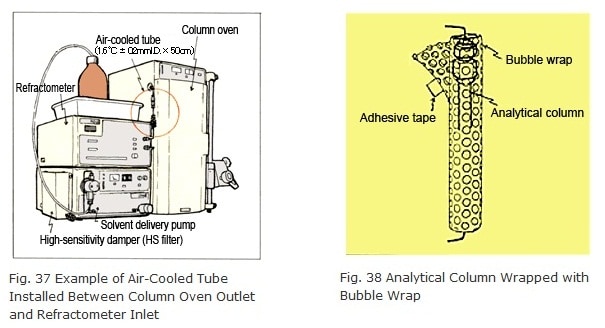6-2) How to Achieve a High Sensitivity Baseline for Sugar Analysis Columns and Refractometers
How to Achieve a High Sensitivity Baseline for Sugar Analysis Columns and Refractometers
In spite of the widespread use of UV detection, refractometers are generally used for sugar analysis and GPC (or SEC - size exclusion chromatography). Refractometers are generally assumed to have poor baseline stability, but the true culprit is often dissolved air in the mobile phase or column temperature variations.
i) Ligand Exchange Columns (such as the Shim-Pack SCR-101P)
To obtain sharp peaks using this type of column, the analytical column temperature must be set close to 80 °C. Therefore, even if the dissolved air level in the mobile phase bottle is at saturated solubility, bubbles can form easily near or downstream from the column outlet. If this occurs, (1) perform online degassing in advance to reduce the dissolved air level or (2) apply a back pressure to inhibit bubble formation. However, in the case of measure (2), refractometers cannot tolerate very much back pressure. If delivering water at 0.8 mL/min, then assume a limit of 0.3 mm I.D. × 50 cm (equivalent to about 0.04 MPa or 0.4 kgcm-2) (assuming no clogging and solution flowing through the sample cell only). In this case, install a restrictor tube before the refractometer. Bubble formation can be inhibited by installing a 0.2 mm I.D. × 50 cm air-cooled tube (water-cooled is acceptable as well) between the column oven outlet and refractometer inlet, as shown in Figure 37, to cool the solution while applying a small amount of pressure.
Typical analytical conditions are indicated below:
Column: Shim-pack SCR-101P (7.9 mm I.D. × 300 mm L)
Mobile Phase: Water
Flow_rate: 0.8 mL/min
Column Temperature: 80 °C
Detector: RID-6A Refractive Index Detector (with temperature control ON and sensitivity of 2 × 10-6 RIUFS)
If only water is used as the mobile phase, fluctuations in the dissolved air content do not have a big effect on refractive index variations. Therefore, if bubbles do not form in the cell, then ligand exchange columns can probably be used for the sensitivity level indicated above without strict degassing.
ii) Normal-Phase Columns (such as the Shim-pack CLC-NH2)
Typical analytical conditions are indicated below:
Column: Shim-pack CLC-NH2 (6 mm I.D. × 150 mm L)
Mobile Phase: Acetonitrile/water (7/3)
Flow_rate: 1.2 mL/min
Column Temperature: Room temperature
Detector: RID-6A Refractive Index Detector (with temperature control ON and sensitivity of 8 × 10-6 RIUFS)
Of these conditions, use particular care when preparing the mobile phase. In gradient systems, it is not appropriate to specify the mixture ratio of acetonitrile and water for solvent delivery, so heated stirring (1) (described in 5-1) is required. For online degassing during analysis, a sealed and pressurized helium purging system should be used. If possible, it is best to keep it at a constant temperature. Analysis at 2 × 10-6 RIUFS is possible in a thermostatically controlled room.
The next consideration is warming the column (or more specifically, dampening minute variations in temperature). Column temperature fluctuates slightly in response to air movement within the room. Consequently, this changes the thickness of the water layer around -NH2 groups and changes the acetonitrile/water ratio in the column eluates. In such cases, wrap the column with three layers of bubble wrap (Figure 38) or use other means to prevent exposing it to direct air flow and dampen any temperature variations.
Even if the column oven is ON, column position and other factors can expose the column to variations in fan air flow levels. This also applies to reversed-phase columns.

|
Note: |
This page is a partially revised html version of LCtalk Special Issue 5 (1991). |






